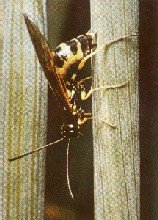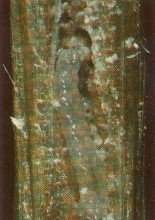Wheat Stem Sawfly


Found in wheat-growing areas throughout the brown soil zone of the Prairies, this pest can be very destructive. Larval feeding within the stem causes lodging and reduces the number of kernels and kernel weight.
Host Crops
Native grasses, wheat, rye, triticale and some varieties of barley.
Biology
The adult sawfly is wasp-like, slender, and about 8-13 mm (3/8-1/2 in.) long. The body colour is shiny-black, with 3 yellow bands on the abdomen. The mature larvae are dull-white, about 13-14 mm (1/2 in.) long, and have a well-defined, brown head. The tail end is covered with stiff bristles. The larva will assume an S-shape when extracted from the stem.
Wheat stem sawflies have one generation per year. The adult emerges in June and can usually be found in wheat fields until mid-July. The adults are very poor flyers and usually do not migrate very far from where they emerged.
The females will not lay eggs in a stem that has already reached the boot stage. The eggs will hatch in 5-8 days. The larvae spend all their time within the stem, feeding for about 30 days. The larva feeds upward through the nodes until the plant starts senescence. Light filtering through the dying stem stimulates the larva to move downward within the stem. Upon reaching a point in the stem at about 2.5 cm (1 in.) above the soil, the larva cuts a V-shaped notch completely around the inside of the stem.
After girdling the stem, the larva plugs the stem immediately below the notch with frass and plant material. After girdling and plugging the stem, the larva continues moving downward within the stem to below the soil line where it will overwinter. The larva then spins a cellophane-like cocoon. The cocoon provides protection from extreme drought and moisture. The pupal stage begins in mid- to late May and lasts about 10 days. To escape from the plugged stub, the adult chews through the stem plug.
| May | June | July | August | September |
| Larvae pupate | Adults emerge, mate, lay eggs | Egg-laying continues, larval feeding starts | Larval feeding continues | Larvae overwinter |
Scouting Techniques
Scout prior to harvest. Stems that contain a sawfly larva usually develop a reddish brown band below the second or third node. Determine percentage of plants cut by sawfly larvae per square metre.
Use a sweep net to sample for wheat stem sawfly. When sweep net samples average 2 female sawflies per 10 sweeps, you can expect about 12% cut stems; 4 females per 10 sweeps cause about 23% cut stems.
If sweep net samples are taken, determine the percent of females found. Remember the female sawfly will have a distinct ovipositor used for inserting the eggs into the stem. Males emerge first; females emerge later.
Economic Thresholds
Control methods are required if 10-15% of the crop in the previous year was cut by the sawfly.
Control Tips
Solid stem wheat varieties are resistant to larval damage. Durum wheats are semi-solid and are rarely attacked by the sawfly. Another method of reducing sawfly populations is to plant an alternate crop that is not susceptible to sawfly infestation.
Shallow, fall tillage can result in 90% sawfly mortality. Spring tillage only provides about 25% sawfly mortality. In minimum till systems, the emphasis should be on host plant resistance, delayed planting of susceptible varieties, and rotations that include non-susceptible crops.
Mowing or grazing of field borders or ditch banks containing native grasses should be avoided because of the possibility of reducing the parasite populations in these areas.
Burning infested stubble may reduce sawfly numbers but it also greatly reduces parasite numbers and the benefits of returning stubble to the soil.
No insecticides are effective for sawfly control.
